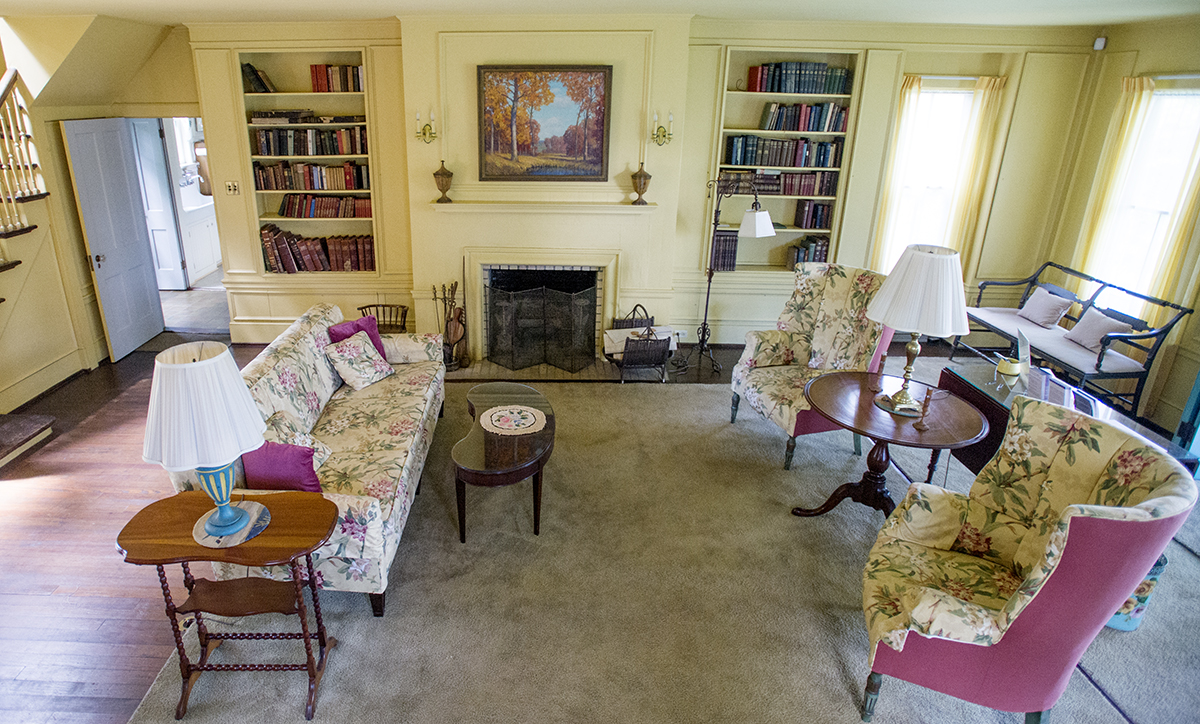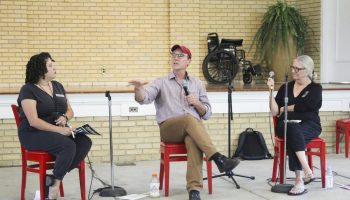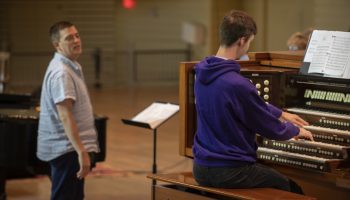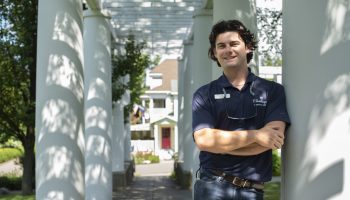The Lewis Miller Cottage is the most historic house on the grounds of Chautauqua Institution. Innumerable famous guests, including presidents and giants of industry and invention, passed through its rooms and gardens. It was named National Historic Landmark in 1966. Yet, beyond everything else, the Miller Cottage was a home — a home to a remarkable American family for 130 years.
Lewis Miller was an inventor, businessman and philanthropist. Born in Stark County, Ohio, in 1829, he founded a farm machinery company and eventually registered 92 patents. His most notable invention was the Buckeye Mower and Reaper, the first combine, which revolutionized farming. Along with John Heyl Vincent, a Methodist clergyman and friend from Akron, Ohio, Miller founded Chautauqua in 1874, first as a summer retreat for Sunday school teachers, and then as a center for lifelong learning. He served as its president from 1874 until his death in 1899.
In 1875, Miller commissioned one of the country’s first prefabricated houses, a Swiss chalet-type structure made of pine and produced piece by piece using a pattern in the “stick style” of the period. He had the pieces shipped by train to Jamestown and from there taken by steamboat to Chautauqua, then called Fair Point, where it was assembled. And there it sits today, at the corner of Whitfield and Vincent, across from Miller Park.
Miller and his wife, the former Mary Valinda Alexander, known as Valinda, had 11 children, whom they raised on their estate, Oak Place, in Akron. In the summers, the family piled into the cottage facing Chautauqua Lake. Lewis and Valinda occupied a bedroom off the living room on the first floor, while the five Miller daughters shared quarters in two bedroom upstairs, and the six Miller sons camped out in an elaborate tent on an elevated platform next to the expansive front porch. President Ulysses S. Grant is said to have taken a nap in the boys’ tent during his visit to Chautauqua in 1875.
Most of the time, the children, like their descendants, were out of the house, swimming, sailing, studying nature and taking part in the classes and lectures that marked the Chautauqua experience from the earliest days. The house was primarily a place to eat and sleep.
Back then, most Chautauquans stayed in tents and makeshift buildings near the lake. A large boarding house was built behind the cottage, and when it was taken down around the turn of the century, its massive stone foundation became the back wall of the Millers’ backyard garden.
In 1885, Thomas Edison began wooing Mina Miller, the ninth child of Lewis and Valinda. Edison was recently widowed with three small children and he fell in love with Mina, who was nearly 20 years younger. He proposed to her, and she accepted, in Morse code while they were sitting together. They went on to have three children of their own (Madeleine, Charles and Theodore) and split their time between Edison’s estate near his laboratories in New Jersey and the cottage. They were together for 45 years, until Edison’s death in 1931.
Mina Miller Edison took charge of the cottage at the turn of the early 20th century, and over the years, particularly in the 1920s, proceeded to update and renovate it. The kitchen she put in was (and is today) tiny. She did not cook and had a private table at the Athenaeum Hotel, where she took virtually all of her meals. She brought in decorators who covered the living room walls with canvas and furnished the house with tasteful colonial and Victorian furniture.
Like most of the Millers, though, Mina was more interested in the outdoors. She hired landscape architect Ellen Biddle Shipman to create formal gardens front and back, filled with lush plantings of rhododendrons, mountain lily, ferns, hydrangeas and hemlock and maple trees that remain today. A fountain was built along the tall back wall. As founder and president of Chautauqua’s Bird and Tree Club, Mina took her gardening seriously.
In 1936, at age 70, Mina married Edward Everett Hughes, a retired steel manufacturer and childhood friend whose family lived a few houses away from the cottage. They took their vows in a small ceremony in the living room on a landing in front of the French doors that open still to the backyard. Hughes died four years later. Resuming the name Edison, Mina spent the rest of her life actively taking part in the Chautauqua community and creating the Thomas Alva Edison Foundation in New Jersey “for the advancement of education and scientific research.”
The children of Thomas and Mina Edison led successful lives and devoted their time between New Jersey and Chautauqua. Madeleine went to Bryn Mawr College and ran for Congress. Theodore became a physicist and later an inventor like his father and worked for the Edison Company. Charles went on to be secretary of the Navy and governor of New Jersey. They and Mina’s younger brother John Miller came and went from the cottage regularly. John and Mina’s brother, Theodore, the baby of the family, joined Theodore Roosevelt’s Rough Riders and was killed at San Juan Hill during the Spanish-American War.
John Miller’s daughter Nancy, born in 1922, was especially fond of Chautauqua and the cottage. Like Mina, she too loved gardening and the natural world. She graduated with a degree in geology from Radcliffe College (now part of Harvard University) and went to work for Gulf Oil. Nancy’s parents both died before she was 18, and her cousin, Charles Edison, became her conservator, and a kind of surrogate father. In the early 1950s, Charles sold the cottage to Nancy, and she spent her summers there until her death in 2007.
Nancy Miller Arnn was as active in the Institution’s affairs as Mina Miller. She was a board member of the Atheneum Hotel for 25 years and a member of the Chautauqua Foundation. Her children Ted, Mina and Kim grew up in Louisville, Kentucky, where Nancy taught school, but spent summers at the cottage from the 1950s until 2015, when Ted and Kim Arnn sold it to the Chautauqua Foundation.
On a recent afternoon, Ted and Kim walked through the house and grounds and reminisced about their lives there.
Each of them recalled working diligently in the garden as children, and Kim remembered passing around hors d’oeuvres to guests at backyard garden parties. They spoke of their uncle Charles who, like his father Thomas Edison, was fond of cigars and used the tall Art Deco ashtray in the living room. Mostly, the talked about the fun they had running around outdoors like their forebears, playing capture the flag and croquet, swimming at the beach, sailing and feasting on the cultural and educational buffet that Chautauqua has always offered.
On rainy days, they played cards in the living room or read some of the books that still line the shelves on each side of the broad fireplace; leather-bound volumes of Dickens, Plutarch and history books for children. They spent a few chilly Christmases there, as well, and Ted lived in the house year-round before he joined the Navy in 1966.
It was an idyllic place, except perhaps when they woke up on occasion to find strangers wandering around downstairs, thinking, as some still do, that the cottage is open to the public, which it is not.
In 2015, the siblings decided to sell the house to the Chautauqua Foundation to ensure that it would kept as a living monument to the family and to the Institution for many years to come. Architects are now working with the Foundation to maintain its structural integrity and open it up for future use by the Institution.
But for Kim Arnn and for Ted Arnn and his wife Mary Boyle and their children, Anna and Molly, the Miller Cottage will always be the home they grew up in and enjoyed, full of history and memories and love.





